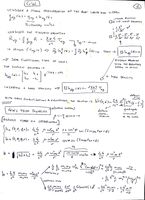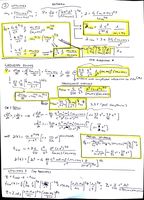Gravitational waves cheat sheet
19/Jun 2015
I would like to share few notes, a cheat sheet, about gravitational waves I put together while writing a chapter of my PhD thesis and preparing for the PhD school internal exam. I did it to tidy up the mess of references and equations you may find around that never agree and has a terrible notation!!
Here the equations, below the images of the papers.
General introduction
Consider a small perturbation of the flat cartedian metric
$$g_{\alpha\beta}(\vec{x}) = \eta_{\alpha\beta} + h_{\alpha\beta}(\vec{x})\label{eq:perturbedMetric}\tag{1}$$
where $\eta_{_{\alpha\beta}}$ is the Minkowsky metric.
Consider the Einstein’s equation
$$R_{\alpha\beta}-\frac{1}{2}g_{\alpha\beta}R = \frac{8\pi G}{c^4}T_{\alpha\beta}\label{eq:EinsteinEquation}\tag{2}$$
where $R_{\alpha\beta}$ is the Ricci tensor, $R$ is the scalar curvature and $T_{\alpha\beta}$
is the stress-energy tensor.
For the metric $\eqref{eq:perturbedMetric}$ and in vacuum ($T_{\alpha\beta}=0$) equation
$\eqref{eq:EinsteinEquation}$ simply becomes
$$ \partial_\beta h_\alpha^\beta(\vec{x})-\frac{1}{2}\partial_\alpha h_\beta^\beta(\vec{x}) = 0\label{eq:gwpartialderivative}\tag{3}$$.
Equation $\eqref{eq:gwpartialderivative}$ can be rewritten using the D’Alambert operator as
$$\square h_{\alpha\beta}(\vec{x}) = 0\label{eq:waveEquation}\tag{4}$$
Where we recognize the wave equation
$$\square \vec{u} = 0$$
with $\square = \frac{1}{c^2}\frac{\partial^2}{\partial t^2}-\nabla^2 = \frac{1}{c^2}\frac{\partial^2}{\partial t^2}-\frac{\partial^2}{\partial x^2}-\frac{\partial^2}{\partial y^2}-\frac{\partial^2}{\partial z^2}$
The simplest solution has form
$$ h_{\alpha\beta}(\vec{x}) = \begin{pmatrix}h_+ & h_\times\\h_\times & -h_+\end{pmatrix}e^{i(kz-\omega t)}\label{eq:simplestSolution}\tag{5}$$
Considering a mass density, source of the gravitational waves, $\eqref{eq:waveEquation}$ becomes
$$\square h_{\alpha\beta}(\vec{x}) = -\frac{16\pi G}{c^4}T_{\alpha\beta}\label{eq:notVacuumWaveEquation}\tag{6}$$
With some simplifying assumptions, equation $\eqref{eq:notVacuumWaveEquation}$
can be integrated and gives (if the source is a distribution of masses at rest,
at a distance $r$ from the observer)
$$h^{ij}(t, \vec{x}) \sim \frac{2 G}{rc^4}\frac{{\rm d} ^2}{{\rm d} t^2}\left[I^{ij}(t-r/c)\right]$$
where $t-r/c$ is the delayed time and
$I^{ij}$ second mass moment or moment of inertia, that is the quadrupole moment of the
mass, $I^{ij} \equiv \int {\rm d}^3 x \rho(t, \vec{x})x^ix^j$.
Gravitational waves from binaries
Assuming edge on observations ($\theta = i = \frac{\pi}{2}\Rightarrow \cos(\theta) = 0$) the wave polarization modes are given by:
$$\begin{aligned}h_{+}(t, \theta, \phi, r) &= \frac{1}{r}\frac{4G\mu\omega_{\rm orb}^2a^2}{c^4}\frac{1+\cos^2\theta}{2}\cos\left(2\omega_{\rm orb}t_{\rm ret}+\phi\right)\\h_{\times}(t, \theta, \phi, r) &= \frac{1}{r}\frac{4G\mu\omega_{\rm orb}^2a^2}{c^4}\cos\theta\sin\left(2\omega_{\rm orb}t_{\rm ret}+\phi\right)\end{aligned}$$
and the final strain (relative deformation caused by the gravitational wave) is
$$h = \frac{4G}{c^4}\frac{\mu\omega_{\rm orb}^2a^2}{r}$$
where $a$ is the semi-major axis of the binary and $r$ the distance source-observer.
$\omega_{\rm gw} = 2\omega_{\rm orb}$.
Substituting the semi-major axis we obtain
$$h = \frac{4 G^2}{c^4}\frac{m_1m_2}{a r}$$
while Substituting the angular frequency from Kepler equations we obtain
$$h = \frac{4 G^{5/3}}{c^4} \frac{m_1m_2}{(m_1+m_2)^{1/3}}\omega_{\rm orb}^{2/3} = \frac{4 G^{5/3}}{c^4} m_{\rm chirp}^{5/3}\omega_{\rm orb}^{2/3}$$
where
$$m_{\rm chirp} \equiv \left(\frac{m_1m_2}{m_1+m_2}\right)^{3/5}(m_1+m_2)^{2/5} = \frac{(m_1m_2)^{3/5}}{(m_1+m_2)^{1/5}}$$
is the chirp mass, a (not so) useful combination of the masses on which both the frequency and the strain of GWs
emitted during the inspiral of a DCOB (double compact object binary) depend.
A handy approximation is given by
$$h\propto \left[\frac{m_{\rm chirp}}{{\rm M}_\odot}\right]^{5/3} \left[\frac{P_{\rm b}}{{\rm hours}}\right]^{-2/3} \left[\frac{r}{{\rm kpc}}\right]^{-1}$$
At the ISCO (innermos stable circular orbit) the strain become
$$h_{\rm ISCO} = \frac{G}{c^2}\frac{1}{r}\frac{m_1m_2}{m_1+m_2} \sim 2.47 \times 10^{-19}\frac{10^6 \,{\rm pc}}{r}\frac{m_1m_2}{m_1+m_2}5\,{\rm M}_\odot$$
The radiated power is
$$\begin{aligned}P &= \frac{{\rm d}E_{\rm orb}}{{\rm d} t} = -\frac{{\rm d}}{{\rm d} t}\left[\frac{Gm_1m_2}{2a}\right] = \frac{Gm_1m_2}{2}\frac{1}{a^2}\frac{{\rm d}a}{{\rm d}t}=\\&=\frac{32}{5}\frac{G^4}{c^5}\frac{1}{a^5}(m_1m_2)^2(m_1+m_2)\quad\text{from quadrupole formalism}\\&=\frac{32}{5}\frac{c^5}{G}\left[\frac{Gm_{\rm chirp}\omega_{\rm GW}}{2c^3}\right]^{10/3}\end{aligned}$$
from which we can derive
$$\frac{{\rm d}\omega_{\rm GW}}{{\rm d}t} = \omega_{\rm GW}^{11/3}m_{\rm chirp}^{5/3}$$
thet gives
$$\omega_{\rm gw} = \left[\frac{64}{5\times2^{2/3}}\right]^{-3/8}\left[\frac{Gm_{\rm chirp}}{c^3}\right]^{-5/8}t_{\rm GW}^{-3/8}$$
and (for circular orbits)
$$t_{\rm GW}\sim\frac{5}{256}\frac{c^5}{G^3}\frac{a^4}{(m_1m_2)(m_1+m_2)}$$
From Peters(1964) we obtain more precise and general relations (~ 3.5PN):
$$\begin{aligned}\langle\frac{{\rm d} E}{{\rm d} t}\rangle &= -\frac{32}{5}\frac{G^4m_1^2m_2^2(m_1+m_2)}{c^5a^5(1-e^2)^{7/2}}\left(1+\frac{73}{24}e^2+\frac{37}{96}e^4\right)\label{eq:energyAverageEmissionRate}\\\langle\frac{{\rm d} L}{{\rm d} t}\rangle &= -\frac{32}{5}\frac{G^{7/2}m_1^2m_2^2(m_1+m_2)^{1/2}}{c^5a^{7/2}(1-e^2)^2}(1+\frac{7}{8}e^2)\label{eq:angularMomentumAverageEmissionRate}\end{aligned}$$
$$\begin{aligned}\langle\frac{{\rm d} a}{{\rm d} t}\rangle &= -\frac{64}{5}\frac{G^3m_1m_2(m_1+m_2)}{c^5a^3(1-e^2)^{7/2}}\left(1+\frac{73}{24}e^2+\frac{37}{96}e^4\right)\label{eq:smaAverageVariation}\\\langle\frac{{\rm d} e}{{\rm d} t}\rangle &= -\frac{304}{15}e\frac{G^3m_1m_2(m_1+m_2)^3}{c^5a^4(1-e^2)^{5/2}}(1+\frac{121}{304}e^2)\label{eq:eccAverageVariation}\end{aligned}$$
$$\label{eq:diffAOnE}\langle\frac{{\rm d} a}{{\rm d} e}\rangle = \frac{12}{19}\frac{a}{e}\frac{\left[1+\frac{73}{24}e^2 + \frac{36}{96}e^4\right]}{(1-e^2)\left[1+\frac{121}{304}e^2\right]}$$
$$\langle\frac{{\rm d} a}{{\rm d} t}\rangle = -\frac{64}{5}\frac{G^3m_1^2m_2^2(m_1+m_2)}{c^5a^3}$$
and integrating from $a_0$ to $a$ and from $t=0$ to $t$ we obtain:
$$\label{eq:AOfTZeroEcc} a(t) = (a_0^4-4Ct)^{1/4}$$
with $C = \frac{64}{5}\frac{G^3m_1^2m_2^2(m_1+m_2)}{c^5}$.
Thus the system merges in a time
$$\label{eq:tGWe0}t_{m\rm gr}(e\rightarrow 0) \sim \frac{a_0^4}{4C}$$
$$t_{m\rm gr}(e\rightarrow 1) \sim 1.8\frac{5}{256} \frac{c^5}{G^3}\frac{a^4(1-e^2)^{7/2}}{(m_1m_2)(m_1+m_2)}\label{eq:tGWe1}$$
Often a slightly different version is used in the literature:
$$\label{eq:tGWliterature}t_{\rm GW} = \frac{5}{256} \frac{c^5}{G^3}\frac{a^4(1-e^2)^{7/2}}{(m_1m_2)(m_1+m_2)}$$
In the same way, for the semi-major axis shrinking, we find
$$\label{eq:AOfTAllEcc}a(t) = \left(a_0^4-4C\frac{t}{(1-e^2)^{7/2}}\right)^{1/4}$$
Utils
Chirp mass
$$m_{\rm chirp} \equiv \left(\frac{m_1m_2}{m_1+m_2}\right)^{3/5}(m_1+m_2)^{2/5} = \frac{(m_1m_2)^{3/5}}{(m_1+m_2)^{1/5}}$$
Kepler
$$P = \frac{2\pi}{\omega} = \left[\frac{4\pi^2 a^3}{G(m_1+m_2)}\right]^{1/2}$$
$$a = \frac{G(m_1+m_2)^{1/3}}{\omega_{\rm orb}^{2/3}}$$
ISCO
At the innermost Stable Circular Orbit (AKA LSO, Last Stable Orbit):
$$\omega_{\rm ISCO} = \frac{2c^3}{6^{3/2}G}\frac{1}{m_1+m_2}$$
$$a_{\rm ISCO} = 3\times\frac{2G(m_1+m_2)}{c^2}$$
Images
References
- Maggiore, M. (2008). Oxford University Press.
- Peters(1964)
- General relativity lectures@Roma1
- Cole Miller lectures

